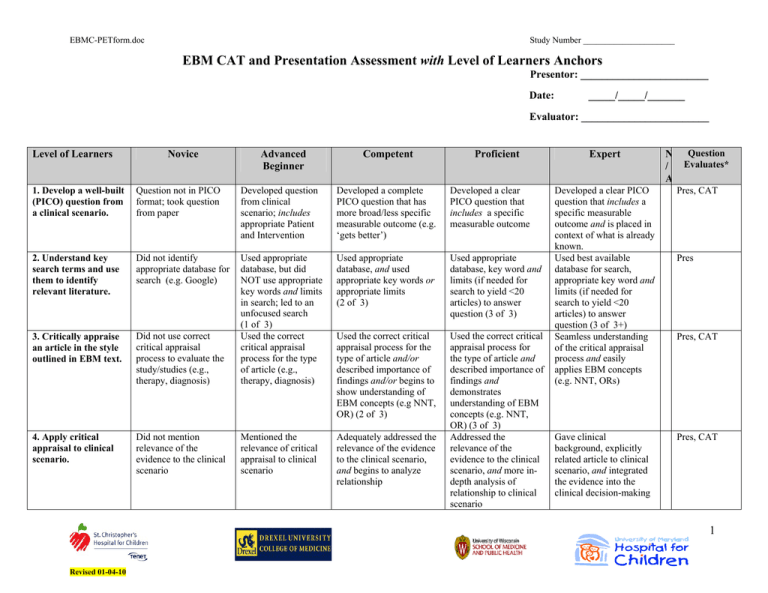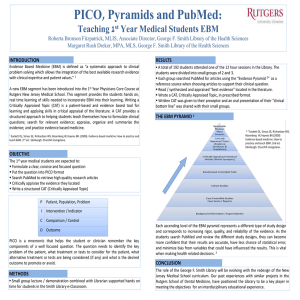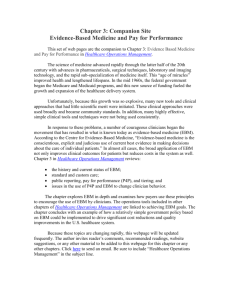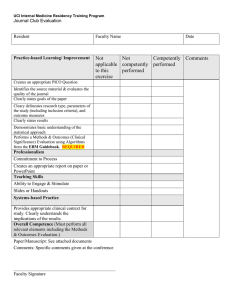EBM CAT and Presentation Assessment with Level of Learners
advertisement

EBMC-PETform.doc Study Number _____________________ EBM CAT and Presentation Assessment with Level of Learners Anchors Presentor: ________________________ Date: _____/_____/_______ Evaluator: ________________________ Level of Learners Novice Advanced Beginner Competent Proficient 1. Develop a well-built (PICO) question from a clinical scenario. Question not in PICO format; took question from paper Developed question from clinical scenario; includes appropriate Patient and Intervention Developed a complete PICO question that has more broad/less specific measurable outcome (e.g. ‘gets better’) Developed a clear PICO question that includes a specific measurable outcome 2. Understand key search terms and use them to identify relevant literature. Did not identify appropriate database for search (e.g. Google) Used appropriate database, and used appropriate key words or appropriate limits (2 of 3) Used appropriate database, key word and limits (if needed for search to yield <20 articles) to answer question (3 of 3) 3. Critically appraise an article in the style outlined in EBM text. Did not use correct critical appraisal process to evaluate the study/studies (e.g., therapy, diagnosis) Used appropriate database, but did NOT use appropriate key words and limits in search; led to an unfocused search (1 of 3) Used the correct critical appraisal process for the type of article (e.g., therapy, diagnosis) Used the correct critical appraisal process for the type of article and/or described importance of findings and/or begins to show understanding of EBM concepts (e.g NNT, OR) (2 of 3) 4. Apply critical appraisal to clinical scenario. Did not mention relevance of the evidence to the clinical scenario Mentioned the relevance of critical appraisal to clinical scenario Adequately addressed the relevance of the evidence to the clinical scenario, and begins to analyze relationship Used the correct critical appraisal process for the type of article and described importance of findings and demonstrates understanding of EBM concepts (e.g. NNT, OR) (3 of 3) Addressed the relevance of the evidence to the clinical scenario, and more indepth analysis of relationship to clinical scenario Expert N / A Question Evaluates* Developed a clear PICO question that includes a specific measurable outcome and is placed in context of what is already known. Used best available database for search, appropriate key word and limits (if needed for search to yield <20 articles) to answer question (3 of 3+) Seamless understanding of the critical appraisal process and easily applies EBM concepts (e.g. NNT, ORs) Pres, CAT Gave clinical background, explicitly related article to clinical scenario, and integrated the evidence into the clinical decision-making Pres, CAT Pres Pres, CAT 1 Revised 01-04-10 EBMC-PETform.doc Study Number _____________________ N / A Level of Learners Novice Advanced Beginner Competent Proficient Expert 5. CAT alone addresses all salient points of the article. CAT did not contain core components and missed major points of the article CAT contains core components, and/or includes most major points of the article, and/or is concise (2 of 3) Does not place the current article into the larger context (i.e. no background information) CAT contains core components, more concisely summarizes study and includes major points of the article (3 of 3) Integrates information from the current study into the larger literature using critical analysis CAT contains core components, concisely and effectively summarizes study, and comments of strength of study [sos] (3 of 3 + sos) Seamlessly integrates information from the current study into the larger literature using critical analysis and communicates how the article affects practice CAT 6. Places the current study in the context of other relevant research on the topic. CAT contains core components, or effectively summarizes or communicated key results (1 of 3) Makes reference to a few other sources of evidence on the topic but does not critically analyze their relationship to the current study 7. Organization and clarity of presentation. Disorganized and unfocused presentation Talk was organized and/or focused and/or emphasized some points (2 of 3) Talk was organized, and focused and emphasized some points (3 of 3) Talk was organized, focused, and explicitly emphasized key points (3 of 3+) Pres 8. Effective use of teaching tools (e.g., PowerPoint, handout). Teaching tool(s) detracted from overall presentation (e.g., tools lack clarity, disorganized, unfocused) Talk was more focused or more organized or emphasized some points (1 of 3) Teaching tool(s) generally was appropriate for the presentation, but some parts of tool lacked clarity or focus Teaching tool(s) added to quality of presentation by organizing the information Teaching tool(s) added to quality of presentation by organizing the information, focusing on and enhancing clarity of key points Pres 9. Synthesized and integrated relevant information. Rote repetition of information without synthesis and end product is undistilled & lengthy Presentation begins to reflect synthesis of information, but still lengthy and/or undistilled Presentation concisely and effectively synthesized information, and begins to integrate information Presentation concisely and effectively synthesized information, and integrates this topic with other information Teaching tool(s) added to quality of presentation by organizing the information, focused on and enhanced clarity of key points and the tool engaged audience in active learning Presentation concisely and effectively synthesized information, and seamlessly integrated this topic with what is already known about this topic Makes reference to a few other sources of evidence on the topic and begins to analyze their relationship to other studies Question Evaluates* Pres, CAT Pres 2 Revised 01-04-10 EBMC-PETform.doc Study Number _____________________ Level of Learners Novice Advanced Beginner Competent Proficient Expert N Question / Evaluates* A 10. Presentation conducted at level appropriate for audience. Presentation did not acknowledge or attempt to engage learners Presentation too simplistic or too complex to engage learners Recognized levels of learners present and effectively engaged some learners Recognized levels of learners present and effectively engaged most levels of learners Effectively engaged all levels of learners using terms appropriate for their level of knowledge Pres 11. Explanation of EBM concepts. Not familiar with EBM concepts and does not attempt to define EBM terms in presentation Poor communication skills (e.g. read presentation or spoke with back to audience) and had no clear teaching points Does not use EBM concepts during exercise Attempts, but is unable to articulate even basic EBM concepts clearly Fair communication skills or had few relevant teaching points Able to articulate some EBM concepts clearly Able to articulate most EBM concepts clearly Pres Either good communication skills or had several effective teaching points Good communication skills and had several effective teaching points Clearly and effectively articulated all EBM concepts relevant to the article being presented Excellent communication skills, had several effective teaching points and presentation was engaging and informative Begins to appraise article, begins to demonstrate understanding of key EBM concepts and calculations. Accurately appraises article and understands key EBM concepts and calculations. 12. Overall teaching skills, as demonstrated through this exercise. 13. Overall EBM skills, as demonstrated through this exercise. Attempts to use EBM concepts during exercise but inaccurately appraised articles using EBM concepts and calculations. Accurately appraises articles, understands key EBM concepts and calculations, and synthesizes information to apply to a patient case. Pres Pres, CAT *Pres = Presentation; CAT = Critically-Appraised Topic Comments: Comments on EBM Skills Comments on Teaching Skills Overall Grade: Novice Advance beginner Competent Proficient Expert 3 Revised 01-04-10



